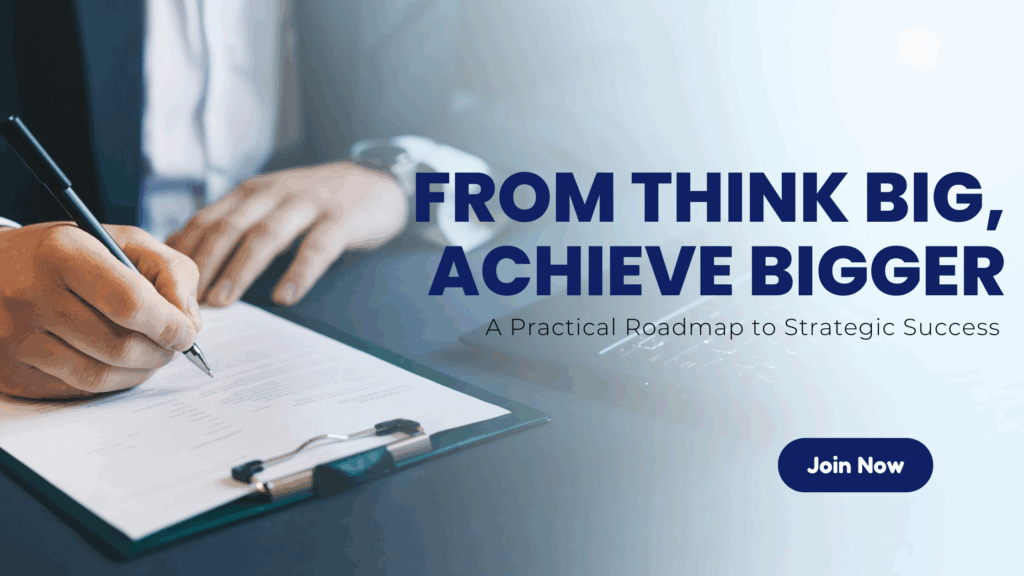In today’s fast-paced business environment, thinking big is no longer a luxury—it’s a necessity. Organizations and leaders who dare to envision bold goals often outperform competitors and drive long-term success. However, big ideas alone are not enough; they must be paired with strategic execution, planning, and practical roadmaps.
This article explores how individuals and organizations can translate ambitious visions into actionable strategies, highlighting key approaches, benefits, challenges, and trends for achieving strategic success.
The Importance of Thinking Big
Thinking big allows leaders to:
Expand possibilities: Break free from conventional constraints.
Foster innovation: Encourage creative problem-solving and new ideas.
Inspire teams: Engage employees with a compelling vision and purpose.
Drive growth: Open opportunities for new markets, products, or services.
However, thinking big must be paired with practical strategies to avoid overreach, resource waste, or misalignment.

Key Steps to Achieve Strategic Success
- Define a Bold Vision
A clear and inspiring vision is the foundation of strategic success. It should be:
Specific yet aspirational: Reflect long-term goals without being vague.
Aligned with organizational values: Ensure the vision resonates with stakeholders.
Communicated effectively: Make sure every team member understands and feels motivated.
Example: A tech startup may set a vision to “revolutionize digital education by making it accessible globally”.
- Set SMART Goals
Breaking a big vision into SMART goals (Specific, Measurable, Achievable, Relevant, Time-bound) transforms abstract ideas into actionable steps.
Benefits:
Provides clarity on priorities
Facilitates tracking progress
Reduces risk of resource misallocation
- Develop a Strategic Roadmap
A strategic roadmap translates vision into actionable initiatives. This includes:
Key milestones: Identify short-term and long-term objectives.
Resource allocation: Assign budget, technology, and personnel efficiently.
Timeline management: Establish deadlines and checkpoints.
Example: A product development roadmap can outline phases for research, prototyping, testing, and launch.
- Foster an Innovation-Driven Culture
Innovation is critical to achieving ambitious goals. Leaders should:
Encourage experimentation and learning from failure
Reward creative solutions and forward-thinking ideas
Leverage collaboration across teams and departments
Impact: Stimulates growth, differentiates the organization, and strengthens competitive advantage.
- Embrace Data-Driven Decision Making
Analytics and business intelligence provide actionable insights for informed decision-making. By monitoring trends, KPIs, and market dynamics, organizations can pivot strategies effectively.
Example: Using customer analytics to identify emerging market needs before competitors.
- Cultivate Leadership & Team Alignment
Strategic success requires strong leadership and engaged teams. Leaders must:
Communicate vision and goals clearly
Empower employees with responsibility and autonomy
Foster collaboration and cross-functional alignment
Impact: Ensures cohesive execution and shared accountability across the organization.
- Continuous Learning & Adaptability
The business landscape evolves rapidly. Continuous learning ensures teams remain up-to-date on trends, technologies, and best practices.
Example: Training programs on emerging tech, leadership, or market analysis help employees adapt and innovate.
Benefits of Thinking Big & Strategic Execution
Accelerated Growth: Bold ideas paired with actionable plans drive rapid expansion.
Competitive Advantage: Innovative approaches differentiate organizations in crowded markets.
Employee Engagement: Inspiring visions motivate teams and foster loyalty.
Better Risk Management: Structured roadmaps reduce uncertainty and enhance decision-making.
Sustainable Success: Strategic thinking ensures long-term results, not just short-term wins.
Challenges in Strategic Execution
Overambitious Goals: Risk of setting unattainable objectives without proper resources.
Resistance to Change: Teams may struggle with new initiatives or unconventional approaches.
Resource Constraints: Limited budget, time, or personnel can impede execution.
Poor Communication: Misalignment of vision and goals leads to inefficiency.
Market Uncertainty: External factors such as competition, regulations, or economic changes may require constant adaptation.
Strategies to Overcome Challenges
Regular Monitoring: Track progress against milestones and KPIs.
Iterative Planning: Adapt strategies based on real-time data and feedback.
Transparent Communication: Ensure all stakeholders understand their roles and objectives.
Empower Teams: Delegate authority and encourage accountability.
Leverage Technology: Use project management tools, analytics, and collaboration platforms for efficiency.
Final Words
Thinking big is the starting point, but achieving bigger requires strategic planning, disciplined execution, and a culture of innovation. Organizations that combine ambition with actionable strategies unlock growth, innovation, and long-term success.
At Ebullient, we specialize in strategic leadership programs and corporate training that empower teams to think big, execute better, and achieve measurable results. Our customized workshops, AI-driven learning modules, and hands-on coaching help organizations transform bold visions into reality.
Explore how Ebullient can help your organization bridge the gap between vision and action at https://ebullient.in. Let’s build a roadmap for success together.
FAQ – Strategic Success & Thinking Big
- How can thinking big benefit my organization?
It inspires innovation, fosters growth, engages employees, and opens new market opportunities. - What is a strategic roadmap?
A roadmap outlines key initiatives, milestones, resources, and timelines to turn vision into action. - How do I ensure my team aligns with a big vision?
Communicate clearly, set measurable goals, foster collaboration, and empower employees with responsibility. - Can bold ideas fail?
Yes, but structured execution, iterative planning, and learning from failures reduce risks and maximize success chances. - How do I measure strategic success?
Track KPIs, project milestones, innovation outcomes, revenue growth, and employee engagement metrics.



